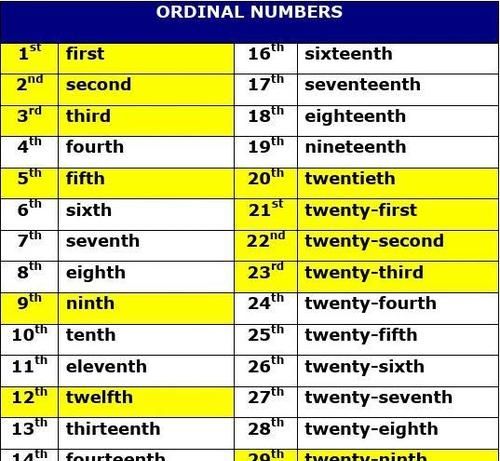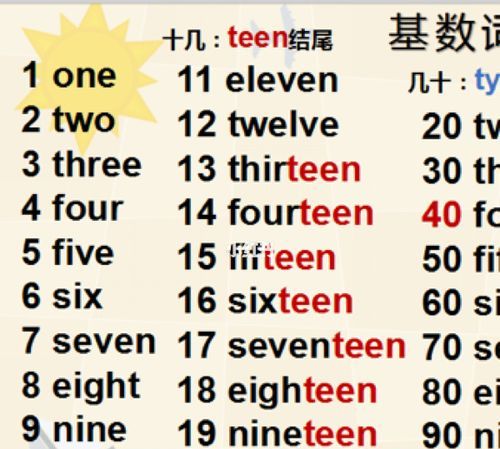本文目录
英语中数词的表达方式

1)小数
3.1416 读作:three point one four one six
0.25 zero pointtwo five (twenty-five)
+4.06 plus fourpoint zero six
-2.002 minus twopoint zero zero two
注意:用小数修饰名词时,超过过1,名词就要用复数:
1.02 meters
1.001 grams
2)分数
分子用基数词表示,分母用序数词,当分子大于1时,分母加s表示复数。
one third 三分之一
two fourths 四分之二
3 读作:three and one eighth
3)车路、车次、门牌、房号、楼层等的表示法
Bus 2, No. 2 Bus, Bus No.2 2路车
Train 28 28次列车
18 Shennan Road 深南路18号
Room 101 101房
F24, Floor 24, the 24th floor 24层
Issue 2092 第2092期
日期:August 14 (th), 1998(14th中的th常省去,但必须念出来)
时刻:10:13 读作:ten thirteen(从冒号处分开念)
11:05 eleven five (0 不用念)
注意:数词本身一般不用复数形式,只有当数词后接of修饰名词时才用复数形式(分数词例外)。
five hundred people 五百人
hundreds of people 数百人
thousands of students 数千学生
millions of dollars 数百万美元
4)加减乘除运算
1 plus 1 equals 2. 1加1等于2。
2 plus 2 makes 4. 2加2等于2。
10 minus 2 equals 8. 10减2等于8。
107 minus 20 equals 87. 107减20等于87。
4 times 4 equals 16. 4乘4等于16。
9 times 10 equals 90. 9乘10等于90。
16 divided by 2 equals 8. 16除以2等于8。
49 divided by 7 equals 7. 49除以7等于7。
本文载自微信公众号“英语语法学习”。本文已获转载授权,版权归作者所有,如需转载,请联系原微信公众号“英语语法学习”。

英语数词怎么记
数词的用法:
1、表示年份:2002:twentythousandandtwo;1976:nineteenseventy-six.
2、表示日期:12月1日:Dec.1st或thefirstofDecember;2002年11月8日:Nov.8th,2002.
3、表示时刻:5:15→fivefifteen或aquarterpastfive;8:30→eightthirty或halfpasteight;10:45→tenforty-five或aquartertoeleven.
4、表示编号:Room105→Roomone0five;BusNo.13→BusNumberThirteen;P.5→PageFive;Tel.No.7658659→TelephoneNumberseven-six-five-eight-six-five-nine
5、小数的读法:5.7→fivepointseven,0.16→zeropointonesix.
6、“半”的表达:1/2→half,半小时→halfanhour,1.5小时→oneandahalfhours或onehourandahalf.
7、序数词前面加the时,表示顺序,加a/an时表示“再一、又一”。如:Thethirdlessonisratherdifficult.(第三课相当难)/Shallwereadthetextathirdtime?(我们把课文读第三遍,好吗?)

英语数词的用法全归纳文库
公共英语数词的用法
想要学好公共英语怎么能不知道数词的用法呢?下面就让我为大家讲解一下吧。

一、概说
数词是指表示数目多少或顺序先后的词。表示数目多少的数词电基数词,如 one, five, ten, thirty, sixty-five 等;表示顺序先后的数词叫序数词,如 first, sixth, tenth, twenty-first 等。数词与不定代词用法相似,在现代英语中,它与不定代词、冠词、指示代词、形容词性物主代词等被称之为限定词。数词用法相当于名词和形容词,在句中可用作主语、宾语、表语、定语、同位语等。
二、基数词
1. 基数词的表示法
(1) 以下是最基本的基数词,学习者必须牢记:one(1), two(2), three(3), four(4), five(5), six(6), seven(7), eight(8), nine(9), ten(10), eleven(11), twelve(12), thirteen(13), fourteen(14), fifteen(15), sixteen(16), seventeen(17), eighteen(18), nineteen(19), twenty(20), thirty(30), forty(40), fifty(50), sixty(60), seventy(70), eighty(80), ninety(90), a hundred(100), a thousand(1000), a million(1000000), a billion (十亿)
(2) 21—99 的表示法。先说“几十”,再说“几”,中间加连字号:twenty-one(21), thirty-six(36), forty-five(45), ninety-nine(99)等。
(3) 101—999的表示法。先说“几百”,后接and,再加末尾两位数(或末位数):one hundred and one(101), five hundred and thirty(530), seventy hundred and eighty-nine(789)
(4) 1000 以上的基数词的表示法。先从右至左数,每三位数加一个逗号(即以此把数目分为若干段)。第一个逗号前的数为thousand(千),第二个逗号前的数million(百万),第三个逗号前的数为billion(十亿),第四个逗号前的数为 trillion(万亿),然后一段一段地数:
9, 883 nine thousand, eight hundred and eighty-three
65, 359 sixty-five thousand, three hundred and fifty-nine
265, 468 two hundred and sixty-five thousand, four hundred and sixty-eight
60, 263, 150 sixty million, two hundred and sixty-three thousand, one hundred and fifty
注:① 英语没有“万”这个单位,要表示“万”须借用thousand,如“一万”用“十千”表示(ten thousand),“十万”用“百千”表示(one hundred thousand)。
② hundred, thousand, million, billion 等词在读数时不带复数词尾-s(即用单数形式)。
③ 在hundred 后通常加上连词,不过此and 在美国英语中可以省略。若读数中没有 hundred,则在thousand后加and。
④一个数的最高位若为“一”,这个“一”可用a或one表示,但在数字中间的“一”,则只能用one,不能用a:
1600 a [one] thousand and six hundred
6100 six thousand and one hundred (其中的 one 不可改为a)
⑤ 在非正式场合,人们也常以hundred 为单位来读数,对于1100至1900之间的整数尤其如此(参见年代的读法):
It cost fifteen hundred pounds. 这东西花了1500英镑。
2. 时刻、日期、年份等的表示法
(1) 时刻的表示法
① 若为整点钟,则直接读相应的基数词;若为非整点钟,则分别以“时”和“分”为单位用相应的基数词读出:twelve(12), eight twenty(8:20), nine forty-five(9:45)
② 对于带“分”的时间,也可借助past(过)和to(差)这两个介词来表示(在美国英语中用after表示“过”)。但是注意,这样表示时“分”不能超过30,否则应作处理,如9.38应处理成“10点差22分”:
9.18 eighteen minutes past (after) nine (= nine eighteen)
10.46 fourteen minutes to eleven (= ten forty-six)
以上分钟后带了minutes一词。若“分”为5, 10, 15, 20 等五的倍数,则可省略minutes:
8.05 five (minutes) past [after] eight (= eight five)
9.20 twenty (minutes) past [after] nine (=nine twenty)
若“分”为15或45,可借用quarter 一词;若“分”为30,可借用half一词:
6.15 a quarter past six 8.45 a quarter to nine 10.30 half past ten
注:时刻表示法分为12小时编时制和24小时编时制。
(2) 日期的表示法:日期的写法(书面语)和读法(口语)稍有不同,如“十月一日”可以写成 October 1, October 1st, 1 October, 1st October, (the) 1st of October 等,表示月份的词也可用缩略式,如 Oct. 1, 1 Oct. 1,但是在口语中通常只有两种读法 October (the) first或the first of October。
注:日期与星期排列时,通常是星期在前,日期在后:He arrived on Friday, May 10. 他于5月10日(星期五)到达。
(3) 年份的表示法:通常以“百”为单位来读。如1986年通常读作 nineteen (hundred and) eighty-six,除非在正式场合,其中的hundred and通常都省,但在通常情况下不能按普通基数词的读法那样读成 one thousand nine hundred and eighty-six。不过,像1500这样的年份可以有两种读法 one thousand five hundred和fifteen hundred,而2000年通常读作 two thousand,2003年读作 two thousand and three。
若表示某个某个年代,则按类似以下的读法:1980s 读作nineteen-eighties(20世纪80年代), 1600s 读作sixteen hundreds(17世纪头10年,即1600—1610), 比较:1300 thirteen hundred(1300年)。
3. 用于复数形式的基数词
(1) 表示整十的'基数词用复数形式可以表示人的岁数或年代:
in the sixties 在60年代 in one’s thirties 在某人30多岁时
(2) 基数词转化为名词,可用复数形式:
How many twos are there in ten? 10里面有几个2?
The soldiers marched in tens. 士兵们10人一排前进。
(3) 某些习语中也用复数形式的基数词:
in [by] twos and threes 三三两两地 at sixes and sevens 乱其八糟
三、序数词
1. 序数词的表示法
(1) 以下是最基本的序数词,学习者必须牢记:first(第1), second(第2), third(第3), fourth (第4), fifth(第5), sixth(第6), seventh(第7), eighth(第8), ninth(第9), tenth(第10), eleventh(第11), twelfth(第12), thirteenth(第13), fourteenth(第14), fifteenth(第15), sixteenth(第16), seventeenth(第17), eighteenth(第18), nineteenth(第19), twentieth(第20), thirtieth(第30), fortieth(第40), fiftieth(第50), sixtieth(第60), seventieth(第70), eightieth(第80), ninetieth(第90)。
注:① 许多序数词是由相应的基数词后加th构成的,如:four / fourth,six / sixth,ten / tenth,sixteen / sixteenth,但是nine变为序数词是ninth,而不是nineth。
② twentieth, thirtieth, fortieth 等表示整十的序数词,由相应的基数词将词尾y改为ie,再加th 构成。
③ first, second, third 通常可缩写为1st, 2nd, 3rd。凡是以th结尾的序数词可缩写为“基数词+th”:4th, 5th, 9th, 11th, 60th, 128th等。
(2) 非整十的多位数,将个位数变成序数词即可:twenty-first(第21),thirty-sixth(第36),ninety-ninth(第99),three hundred and sixty-fifth(第365)等。
(3) hundred, thousand, million 等序数词形式为 hundredth, thousandth, millionth 等:
five hundredth (500th) 第500 ten thousandth (10, 000th) 第10000)
注意:这类词前用数字“一”时,这个“一”只用one,不用a:
one hundredth 第100(不说a hundredth)
2. 既可序数词也可用基数词的场合
(1) 日期的表示法通常用序数词,也可用基数词,如“5月5日”在书面语中通常写成5 May(英)或May 5th(美),而在口语中则通常说成 the fifth of May,May the fifth(英), May fifth(美)等。
(2) 在类似编号的场合,用序数词应放在被修饰词语之前,若用基数词则置于其后:
the First Lesson / lesson one 第一课 the tenth chapter / chapter ten 第10章
the sixth line / line 6 第6 行 the third part / part three 第三部分
但是,在许多情况下,用基数词比用序数词更合适、更方便:
Book One 第一册 Room 805 805房
page 110 第110页 Bus Number Ten 第10路公共汽车
3. 序数词前使用冠词应注意的两点
(1) 序数词前通常要用定冠词
It’s the third time I’ve been here. 这是我第三次来这儿。
The second is better than the first. 第二个比第一个好。
注:① 表示考试或比赛等的名次时,通常省略定冠词:
She was (the) third in the exam. 她考试得了第三名。
②序数词用作副词时也通常不用冠词:
He came first. 他先来。
I’ll have to finish my homework first. 我得先把作业做完。
③有些习语中的序数词前没有冠词:
at first 开始 at first sight 乍看起来 first of all 首先
④ 但若序数词前用了物主代词或名词所有格,则不能再用定冠词:
his second wife 他的第二个妻子 Tom’s third book 汤姆的第三本书
(2) 序数词前有时可用不定冠词,表示次第在原有基础上的增加:
A second student stood up. 又一个(第二个)学生站了起来。
I want to read the book a third time. 这本书我想读第三次。
序数词前用定冠词和不定冠词的区别在于,定冠词表特指,不定冠词表泛指,有类似another的意思,但比another 的意思更明确:
I like the third girl. 我喜欢第三个女孩。(至少有三个女孩供选择,特指)
I saw a third girl. 我又看见了第三个女孩。(暗示原来已看见两个,这已是第三个)
三、分数、倍数、小数和百分数的表示法
1. 分数的表示法。分数由基数词和序数构成——分子用基数词,分母用序数,分子超过“1”时,分母用复数:a [one] sixth(1), two thirds(2), three fifths()3)
注:(1) 1 通常读作 a [one] half,一般不读作a second。
(2) 1 可读作 a [one] fourth,也可读作 a [one] quarter。
(3) 分子超过“1”分母之所以用复数可以这样理解:“三分之二”即两个(two)三分之一(third),既然是两个“三分之一”,那“三分之一”当然要用复数,即用thirds。
(4) 在数学上,为了简洁起见,分子和分母均可用基数词,其间用介词over:3 读作three over four(对于比较复杂的分数通常采用此读法)
(5) 带分数的读法:在整数与分数之间用and连接:five and two thirds
2. 倍数的表示法。表示倍数时通常借助half, double, twice, three times等之类的词:
Half (of) the apples are bad. 一半苹果是坏的。
His homework is not yet half done. 他的作业还没完成一半。
He eats twice what I eat. 他的食量是我的两倍。
比较以下三句,虽然表达形式不同,但含义相同:
(1) This rope is three times as long as that one. 这根绳子是那根的三倍长。
(2) This rope is three times longer than that one. 这根绳子是那根的三倍长。
(3) This rope is three times the length of that one. 这根绳子是那根的三倍长。
第(1)句和第(3)句的意思比较清楚,但第(2)句常容易误解,有人认为它与其他两句意思不同,应理解为“这根绳子比那根绳子长三倍”,但绝大多数语法学家并不这样认为,而是认为以上三句意思相同。
3. 小数的表示法。与汉语一样,小数点前的数按普通基数词的读法读,小数点后的数按单个数字一一读出。小数点后的0通常读作oh,有时也读作nought或zero,小数点读作point:one point five six(1.56), ten point three oh five(10.305)
注:被大于“1”的小数修饰的名词要用复数,如说 1.3 meters,不说1.3 meter;即使是被小于“1”的小数修饰,名词也通常可以用复数:One centimeter equals 0.3937 inches. 1厘米等于0.3937英寸。
4. 百分数的表示法。百分数由基数词(或小数)和百分号(%)组成,百分号(%)读作 per cent:fifteen percent(15%), (zero) point six percent(0.6%)
注:百分数后接名词时有时用介词of,有时不用:30% of the students(30%的学生),a 30% chance(30%的把握)。两者的区别是:后接介词of时,percent 为名词,of表示整体中的部分;不接介词of时,percent 为形容词(此时不表示整体与部分的关系),再比较:6 percent of the interest=利息中的百分之六,at 6 percent interest=按百分之六的利息。
四、约数的表示法
1. 大于某数的表示法。可用 more than, over, or more等表示:
more than fifty people 五十多个人
children of fourteen and over 十四岁和十四岁以上的少年
sixty students or more 六十或六十多个学生
2. 小于某数的表示法。可用less than, under, or less, up to, almost, nearly 等:
It cost me less than 10 pounds. 我买它没要上10英镑。
Children under six years old are admitted free. 未满6岁的儿童可免费入场。
It’s nearly [almost] 10 o’clock.. 快两点了。
The temperature is five degrees below zero. 温度是零下5度。
3. 大约数的表示法。可用or, or so, about, around, round, some, more or less 等表示:
I’ll come back in three or four days. 我过三四天就回来。
We stayed or an hour or so. 我们停留了一个小时左右。
It will cost around (round, about) 100 dollars. 那大概要100美元。
Some 100 people attended the meeting. 大约100参加了会议。
I read more or less forty pages last night. 我昨晚看了大约40页。
注:要表示“一两分钟”这样的意思,通常用a minute or two 或 one or two minutes,而不用 one minute or two。
五、数词的句法功能
1. 用作主语:
The second is yours. 第二个是你的。
It’s said that 13 is an unlucky number. 据说13是一个不吉利的数字。
2. 用作表语:
Her father is sixty-five. 她父亲65岁。
Two thirds of the apples were bad. 三分之二的苹果是坏的。
3. 用作宾语:
I know three of them. 他们当中有三个有我认识。
Please give me the third. 请给我第三个。
4. 用作定语:
He has three English dictionaries. 他有三本英语词典。
The second one is more expensive. 第二个更贵。
The rope is only 2.15 meters long. 这根绳子只有2.15米长。
5. 用作同位语:
Are you two reading? 你们两人都在看书吗?
Let us four finish the work. 让我们四个人完成这工作吧。
Who is that man, the first in the front row? 前排第一个是准?
6. 用作状语:
I hate riding two on a bike. 我不喜欢骑自行带人。
Think first, then act. 先想清楚再行动。
We agree with you a hundred percent. 我们百分之百同意你。
;英语数词的用法总结
数词分为两类,1. 基数词2. 序数词
表示数目的词或者是用来数数的词称为基数词。其形式如下:A.从1——10 one,two,three,four,five,six,seven,eight,nine,ten。B.从 11——19 eleven,twelve, thirteen, fourteen, fifteen,sixteen,seventeen,eighteen,nineteen.这里除eleven, twelve, 为特殊形式外,fourteen,sixteen,都是由其个位数形式后添加后缀-teen构成。20-90是twenty,thirty,fourty,fifty,sixty,seventy,eighty,ninety.21-29,31-39,是twenty,thirty之后加one,two....以此类推。
序数词 序数词的构成及其说明
1) 序数词第一、第二和第三为first, second和third,其他序数词的构成是在基数词后加th。例如:
six→sixth seven→seventh ten→tenth four→fourth
2) fifth(第五)、 eigth (第八)、 ninth (第九)和twelfth (第十二)在拼法上有变化。
3) 二十、三十等基数词变为序数词时,要把y变成ie再加-th。例如:
twenty→twentieth forty→fortieth
4) 基数词几十几变成序数词时,表示几十的数词不变,只把表示几的基数词变成序数词。例如:
twenty-one→twenty-first forty-five→forty-fifth
5) 第一百、第一千、第一百万、第十亿都是在基数词后直接加th构成。例如:
第一百→hundredth 第一千→thousandth第一百万→millionth 第十亿→billionth
6).序数词的缩略形式是由阿拉伯数字加序数词的最后两个字母构成。例如:
1st,2nd,3rd,4th,21st,32nd,40th
2.序数词在句子中的应用
序数词在句中主要是充当定语,也可以作主语、表语、宾语,前面要加定冠词the。例如
The first time I came to China,I liked it very much.
我第一次来中国,我就非常喜欢这个国家。
The first is always better than the second.第一总是比第二好。
She will choose the third. 她将选择第三。
四、数词的其他用法
1.分数
分数由基数词和序数词合成。分子用基数词,分母用序数词。分子是1.时,分母(序数词)用单数形式;分子大于1时,分母用复数形式,序数词加-s。读带分数时,先读整数部分,再读分数部分。例如:
1/2→one half 或 a half 1/4→one fourth 或 one (a) quarter
3/4→three quarters或 three fourths 4/5→four fifths
2-1/3→two and a (one)third3-5/6→three and five sixths
32-3/4→thirty-two and three quarters(three fourths)
2.小数
整数与小数之间用小数点隔开。读小数时,每位数字(特别是小数点后面的)要单独读出。小数点读作point(点),零读作zero(或naught)。如果整数是零,往往不读出。例如:
0.1→zero(naught)point one,或point one
0.03→zero(naught)point naught three或zero point zero three
2.25→two point two five14.163→fourteen point one six three
205.37→two hundred and five point three seven
注意. ①和带分数连用的名词,用复数。 例如:
3-1/2.hours读作:three and a half hours或three hours and a half
②如果带分数的整数部分是1,名词读在带分数之后时,名词要用复数;而名词读在1与分数之间时,名词则用单数。 例如:
1-1/2.tons读作:one and a half tons或one (a)ton and a half
1-1/3.miles读作:one and a third miles或one (a)mile and a third
③与小数连用的名词的数:整数是零时,名词用单数形式,其他情况名词用复数形式。 例如:
0.27.metre→zero point two seven of a metre1.26.metres→one point two six metres
3.百分数
百分数用下面形式表示:
5%→5.per cent(缩写:5.PC)读作:five percent
23%→23.per cent(缩写:23.PC)读作:twenty-three percent
4.常见的数字符号和等式的读法
=(等于号)读作 equals+(加号)读作 plus或and例如:
3+2=5.Three plus two equals(或is) five.或Three and two is (或are) five.或Three and two make five.
-(减号)读作minus例如:5-3=2. Five minus three equals(或is) two.
×(乘号)读作times 或multiplied by例如:
8×7=56. Eight times seven equals (或is)fifty-six.或Eight multiplied by seven is fifty-six.或Eight sevens are fifty-six.÷(除号)读作divided by例如:
10÷5=2Ten divided by five equals(或is)two.
5.时刻表达法
表示时刻有两种说法:
1)先说分钟,后说钟点。几点过几分,分钟不超过三十分钟时用past。例如:
It’s five past seven now. 现在是七点(过)五分。
几点差几分或差几分几点,差的分钟数不超过二十九分钟时,用to。例如:
It’s twenty-nine to five. 五点差二十九分。
It’s a quarter to six. 差一刻六点。
2)先说钟点,后说分钟。在日常生活中,为了简便,常用这种说法。例如:
It’s six thirty.六点三十分。
6.年、月、日表达法
1)年份用基数词,日期用序数词。例如:
1988年5月1日可以写作 May 1(st),1988,读作May the first,nineteen eighty-eight;也可以写作
1(st)May,1988,读作the first of May,nineteen eighty-eight
2)英语年份的读法:一般先读前两位数,再读后两位数。例如:
1983→nineteen eighty-three1700→seventeen hundred
1870→eighteen seventy1601→sixteen a one或sixteen hundred and one
965→nine sixty-five 或nine six five
注意. ①日期可全用阿拉伯数字,但是英国人和美国人的写法不同。英国人先写日子,美国人则先写月份。 例如:
6,8,1988=1988年8月6日(英国)=1988年6月8日(美国)
②年份的后面不用year(年),但有时前面有用year的, 如in the year 1949(读作in the year nineteen forty-nine)。
③公元前的年份后面加 B.C.(采用before Christ的第一个字母,意思是公元前)。 如221. B.C. 可读作two twenty-one B.C. (公元前221年)。公元后的年份一般在后面加A. D.(拉丁语Anno Domini的第一个字母,in the year of the Lord,意思是公元)。有时也有把A. D.加在前面的,如A. D. 1949(=1949.A. D.)。
3)年代用年份的阿拉伯数字加-’s 或-s表示。例如:
十八世纪三十年代→1730’s/1730s the seventeen thirties
二十世纪六十年代→1960’s/1960s the nineteen sixties
八十年代初期→the early eighties九十年代末期→the late nineties
二十世纪六十年代中期→the mid 1960’s (1960s)/the mid nineteen sixties
4)月份。一年12个月的英语写法如下。
一月→January 二月→February三月→March四月→April
五月→May六月→June七月→July八月→August
九月→September十月→October十一月→November十二月→December
7.half的用法
1)“half a(an)+名词”或“a half+名词”表示“一半……”。例如:
half a kilo 半公斤 half an hour 半小时
a half day 半天 a half building 半座楼
2).“一个半”的表示法
表示“一个半”有两种表示法。例如:
一个半小时 one hour and a half one and a half hours
四个半橘子 four oranges and a half four and a half oranges
8.大约数表达法
表示“大约……”可以用about(or so),aost(nearly),less than(under少于),more than(over多于)等表示。例如:
Three or four hours later,he will leave China for Japan by plane.
三四个小时后,他将乘飞机离开中国去日本。
They stayed in China nearly one month last year.去年他们在中国呆了将近一个月。
My home is less than ten kilometers away from our school.我家离学校不到十公里远。
9.电话号码及编号
编号既可以用序数词,也可用基数词。例如:
the tenth lesson Lesson Ten 第十课
the fiftieth page page 50第五十页
有的编号习惯上常用基数词。例如:
Room 321(读作three two one) 321号房间
Tel.No.4013586(读作Telephone number four 0 one three five eight six) 电话号码4013586
这和汉语中有时不用第几而用基数词表示序数的用法相同。如:三楼、一百二十二号等。
五、数词与其他词的连用
1. a second time, a third one表示“又一”、 “再一”
Would you like to come to Beijing a second time?你还愿意再次来北京吗?
After eating two cakes,he ate a third one.吃了两块蛋糕后,他又吃了一块。
对比:He has been in Japan for the first time.他第一次来日本。
2.“数词+名词(单数)”用作定语
She is a five-year-old Chinese girl.她是一个五岁的中国女孩。
We’ll have a two-month holiday.我们将拥有一个两个月的假期。
This is a ten-metre-tall tree.这是一棵十米高的树。
。

以上就是关于数词英语怎么用 ,英语中数词的表达方式的全部内容,以及数词英语怎么用 的相关内容,希望能够帮到您。
